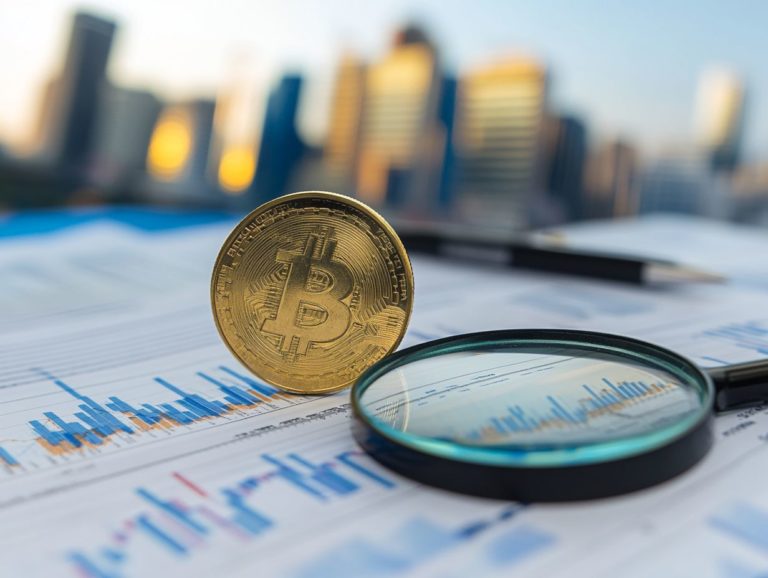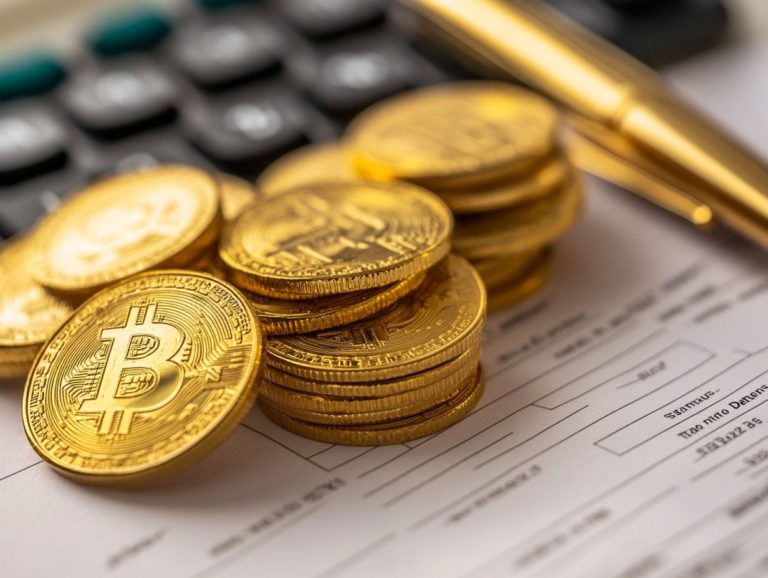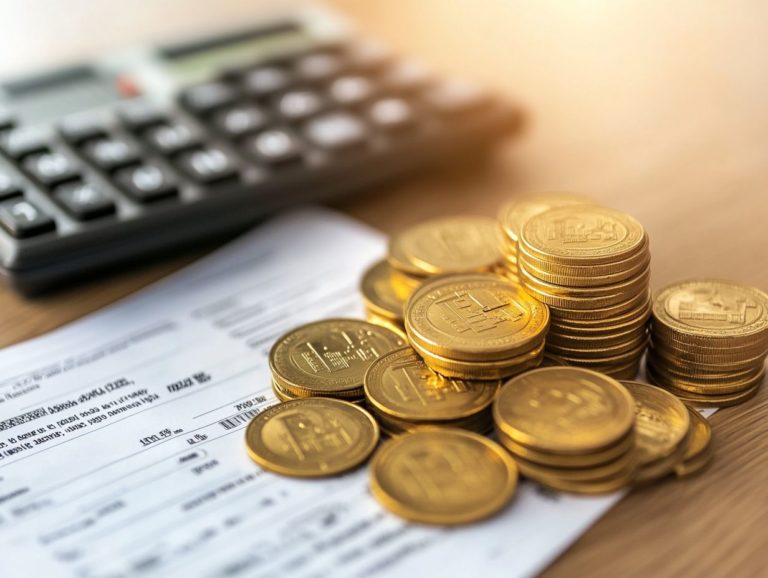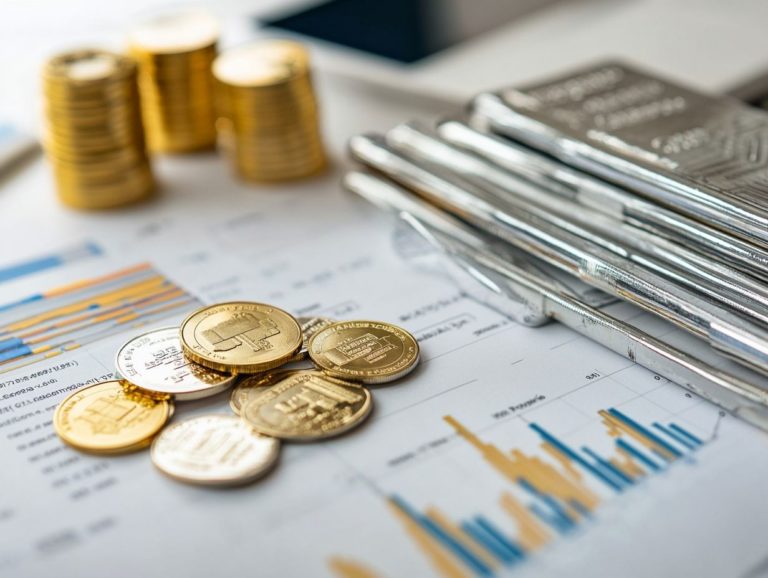Tax Strategies for Precious Metals in a Diversified Portfolio
Investing in precious metals can be a smart choice if you’re looking to diversify your portfolio. These commodities offer unique advantages, such as acting as a hedge against inflation, but they also come with specific risks and tax implications that you need to be aware of.
This guide will illuminate the role of precious metals in your investment strategies. It will detail the taxes you might encounter, effective tax strategies, and the benefits of using tax-advantaged accounts.
Whether you re a seasoned investor or just starting out, this overview will equip you with the essential knowledge to make informed decisions in the precious metals market.
Contents
- Key Takeaways:
- The Role of Precious Metals in a Diversified Portfolio
- Tax Implications of Investing in Precious Metals
- Types of Taxes on Precious Metals
- Tax Strategies for Maximizing Investments
- Diversifying with Precious Metals in a Tax-Efficient Manner
- Balancing Tax Efficiency and Portfolio Diversification
- Tax-Advantaged Accounts for Investing in Precious Metals
- Tax Reporting for Precious Metals Investments
- Frequently Asked Questions
- What are the benefits of including precious metals in a diversified portfolio?
- Do I have to pay taxes on my gains from selling precious metals in my portfolio?
- What are some tax strategies for reducing taxes on precious metals in a diversified portfolio?
- Can I use precious metals to offset gains from other investments in my portfolio?
- Are there any taxes on holding physical precious metals in a portfolio?
- What if I inherit precious metals in a diversified portfolio?
Key Takeaways:
- Diversify with precious metals for a strong portfolio, but be aware of risks and benefits.
- Maximize investments by using tax strategies, such as the timing of buying and selling.
- Utilize tax-advantaged accounts, like IRAs and 401(k)s, for investing in precious metals.
The Role of Precious Metals in a Diversified Portfolio
Precious metals like gold, silver, platinum, and palladium are vital for enriching your portfolio diversification. They serve as a safeguard against inflation and act as a reliable store of value.
Amidst economic uncertainty and ever-changing market dynamics, savvy investors are increasingly drawn to these tangible assets to enhance their financial strategies. Adding precious metals to your portfolio can help you manage risk while seeking financial growth. It’s also crucial to be aware of the tax obligations of precious metals to ensure a well-rounded investment approach.
Benefits and Risks of Investing in Precious Metals
Investing in precious metals presents a unique mix of benefits and risks. The primary advantages include their historical role as safe haven assets during turbulent market conditions and their collectible value offered by select pieces. Be aware of the risks to protect your investments! Price volatility and shifting market dynamics can create challenges.
By diversifying your portfolio with assets like gold and silver, you can effectively manage risk. This strategy can help you safeguard against currency devaluation, especially during inflationary periods. Keep an eye out, as sudden price fluctuations can lead to losses if not monitored.
Consider employing dollar-cost averaging to spread your investments over time. A balanced approach that combines physical holdings with exchange-traded funds (ETFs) can be beneficial. Additionally, it’s wise to understand tax planning for precious metals in a diversified portfolio. These strategies allow you to enjoy the advantages of precious metals while navigating the risks of this investment landscape.
Tax Implications of Investing in Precious Metals
Understanding the tax implications of investing in precious metals is crucial for maximizing your financial growth while adhering to tax regulations. Different forms of precious metals, like bullion and collectible coins, may incur capital gains tax upon sale. This highlights the importance of meticulous record-keeping and following reporting requirements, such as Form 8949 and Schedule D.
Consulting with a tax professional can be invaluable. They can help minimize your tax liability and guide you through these complexities.
If you re ready to take the next step in your investment journey, consider consulting with a financial advisor to explore how precious metals can fit into your strategy.
Types of Taxes on Precious Metals
As an investor in precious metals, it s crucial to be aware of the various types of taxes that may apply, such as capital gains tax and sales tax on your purchases.
The Internal Revenue Service (IRS) categorizes precious metals as collectibles, resulting in higher tax rates than those for other investment assets in your portfolio.
This classification means that when you sell your precious metals, you may face a capital gains tax rate of up to 28%. This is significantly higher than the standard long-term capital gains tax rate of 15% or 20% that applies to assets like stocks or bonds.
Many states also impose a sales tax on purchases of precious metals, with rates that can vary widely. This can further eat into your overall returns.
Understanding these tax implications can greatly influence your decisions on when to buy or sell, as well as what types of metals to include in your investments.
Planning for these taxes is essential to maximize your after-tax returns and ensure that your investment strategies align with your financial goals.
Tax Strategies for Maximizing Investments
Employing effective tax strategies is essential to maximize your returns on precious metal investments while minimizing tax liability.
Consider utilizing tax-advantaged accounts, like IRAs, to defer taxes on capital gains. Diligent reporting of transactions can also optimize your financial outcomes.
Consulting a tax professional can provide insights into best practices tailored specifically to your investment decisions.
By understanding the nuances of different investment vehicles, you can make informed choices that align with your financial goals.
A self-directed IRA, which allows you to choose your investments, offers a wider array of options while enjoying favorable tax treatment.
Record-keeping is crucial; accurate tracking of your purchases and sales ensures compliance and transparency, safeguarding you against potential audits.
A knowledgeable tax advisor can help you identify deductions and credits specific to your investment activities, enhancing your overall returns.
This ultimately leads to more effective long-term wealth accumulation.
Diversifying with Precious Metals in a Tax-Efficient Manner
Diversifying your portfolio with precious metals in a tax-efficient manner calls for a meticulous approach to your investment strategies.
Minimizing tax implications while enhancing your portfolio’s diversity is essential.
By thoughtfully integrating tangible assets such as gold and silver, you can reduce financial risks, optimize returns, and navigate the complexities of tax regulations effectively.
Balancing Tax Efficiency and Portfolio Diversification
Balancing tax efficiency with portfolio diversification is crucial if you’re aiming to optimize your precious metals holdings.
Your investment strategies should align with risk management principles and address the economic uncertainty that often looms over the precious metals market.
Incorporating tax-advantaged accounts like IRAs or HSAs enhances your potential returns without immediate tax liabilities.
A well-crafted mix of physical and paper assets can offer greater liquidity while helping to mitigate risks associated with economic fluctuations.
Allocating a portion of your portfolio to precious metals like gold and silver serves as a solid hedge against inflation and aids in capital preservation during market volatility.
Utilizing strategies like dollar-cost averaging can help you achieve the ideal balance, allowing for opportunistic buys regardless of market conditions.
Tax-Advantaged Accounts for Investing in Precious Metals
Utilizing tax-advantaged accounts like IRAs and 401(k)s for investing in precious metals significantly enhances your financial growth while providing substantial tax benefits.
These accounts enable you to hold physical metals or ETFs without facing immediate tax implications, allowing for a more strategic and thoughtful approach to asset allocation.
Take charge of your investment strategy today and explore how you can optimize your returns!
IRA and 401(k) Options for Precious Metals
You have various options within IRAs and 401(k)s to incorporate precious metals into your retirement planning, leading to enhanced investment choices and tax advantages. These accounts allow you to hold gold, silver, and other approved precious metals as part of a diversified portfolio while adhering to specific rules set by the Internal Revenue Service.
By following these guidelines, you can enjoy tax-deferred growth or tax-free distributions, depending on whether you choose traditional or Roth accounts. With traditional IRAs, you receive an immediate tax deduction on your contributions. Roth IRAs offer the appeal of tax-free withdrawals in retirement ideal for long-term financial strategies.
Keep in mind that your investments in precious metals need to meet the purity requirements specified by the IRS. Understanding these nuances enables you to make informed decisions that align perfectly with your financial goals.
Tax Reporting for Precious Metals Investments
Tax reporting for precious metals investments is essential for maintaining compliance with IRS regulations. Ensure accurate completion of forms like Form 8949 and Schedule D.
Keep detailed records of your transactions to meet specific reporting requirements, as they can differ depending on the type of precious metals you hold, including understanding your tax obligations for precious metals.
Understanding Tax Forms and Requirements
Understanding the various tax forms and requirements is crucial for you as an investor in precious metals. Key forms, like Form 8949 and Schedule D, are vital for reporting your transactions and calculating any capital gains or losses related to your investments.
When you sell precious metals, Form 1099-B may come into play, reporting the proceeds from the sale that you need to input accurately. Familiarity with these forms is crucial for tracking all your purchases and sales meticulously, ensuring that every detail aligns with IRS expectations.
Failing to comply with these regulations can lead to significant penalties! Stay informed and grasp the nuances of each form and the process for completing them. This knowledge will help you navigate the complexities of tax season with confidence and sidestep any unwarranted complications.
Frequently Asked Questions
What are the benefits of including precious metals in a diversified portfolio?
Precious metals, such as gold, silver, and platinum, provide diversification and act as a hedge against inflation. They are also considered a safe haven during economic uncertainty.
Do I have to pay taxes on my gains from selling precious metals in my portfolio?
Absolutely! When you sell precious metals, you ll need to account for capital gains taxes. However, there are tax strategies that can help minimize your tax burden.
What are some tax strategies for reducing taxes on precious metals in a diversified portfolio?
One effective strategy is to hold onto the precious metals for at least a year before selling, which qualifies the gains for long-term capital gains tax rates typically lower than short-term rates. Another strategy is to use a tax-advantaged account, like a self-directed IRA, to hold the precious metals. This can defer or eliminate taxes on gains until they are withdrawn from the account.
Can I use precious metals to offset gains from other investments in my portfolio?
Yes, if you have losses from other investments, you can sell your precious metals at a loss to offset these gains. This can help decrease your overall tax liability.
Are there any taxes on holding physical precious metals in a portfolio?
There are no taxes on holding physical precious metals, such as gold coins or bars, in a portfolio. However, if these metals generate income, like interest or dividends, they may be subject to taxes.
What if I inherit precious metals in a diversified portfolio?
Inheriting precious metals can have tax implications depending on their value and type. Consult with a tax professional to understand any applicable taxes and develop a strategy for managing the inherited metals.















